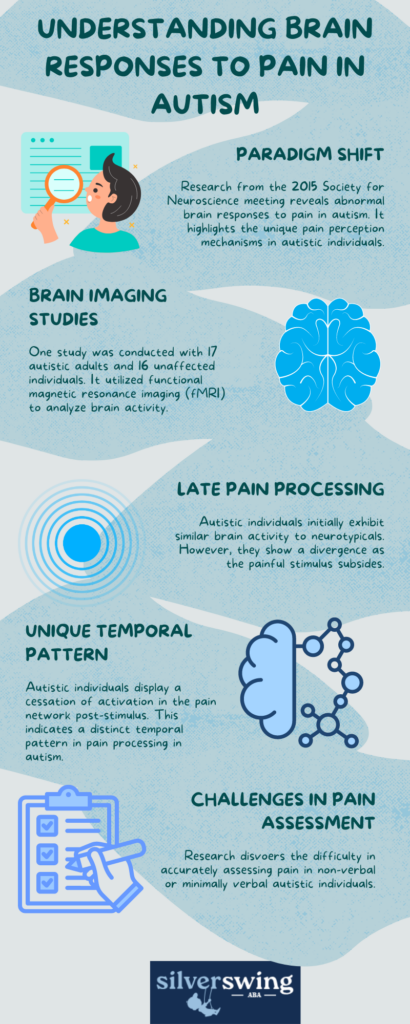Understanding how pain is experienced by individuals with autism spectrum disorder (ASD) is crucial for caregivers and parents to provide appropriate support and care. Recent research sheds light on the complex relationship between autism and pain tolerance, offering insights that can help improve the well-being of autistic individuals.

Brain Responses to Pain in Autism
The groundbreaking research presented at the 2015 Society for Neuroscience annual meeting delves into how individuals with autism process pain stimuli. Unveiling a paradigm shift, the study unveils abnormal brain responses among autistic individuals when exposed to painful stimuli, providing invaluable insights into their pain perception mechanisms.
Conducted as one of the pioneering brain imaging studies in autism, the research involved 17 adults with autism and 16 unaffected individuals. Utilizing functional magnetic resonance imaging (fMRI), participants were subjected to a controlled experiment where a small piece of metal heated to 49 degrees Celsius was applied to their skin.
During the early phase of pain processing, autistic individuals exhibited levels of brain activity akin to neurotypical counterparts. However, as the painful stimulus subsided, a notable divergence surfaced. While control subjects retained brain activity indicative of pain processing, autistic individuals displayed a cessation of activation in the pain network.
This disparity persisted even after the cessation of the painful stimulus, indicating a unique temporal pattern in pain processing among autistic individuals. Despite these differences in brain responses, both groups reported similar pain intensity ratings, underscoring the challenge of accurately assessing pain in non-verbal or minimally verbal individuals with autism.
The findings hint at the complexity of pain perception in autism, suggesting that while initial processing may align with typical patterns, subsequent cognitive and emotional evaluation of pain diverges. Moreover, variability in brain responses underscores the diverse sensory sensitivities inherent in autism spectrum disorder.
Looking ahead, researchers aim to explore complementary methodologies to enhance the understanding of pain experiences in autistic individuals. By amalgamating brain imaging with alternate pain assessment modalities, the study envisions a holistic approach to deciphering pain perception in those who struggle to articulate their experiences verbally.
Autism and Pain Sensitivity
Published in the prestigious PAIN journal, a groundbreaking study involved 52 adults with high-functioning autism, making it the largest study of its kind worldwide. Using detailed tests, researchers carefully looked at how these individuals feel and deal with pain.
Dr. Bar-Shalita explains, “Our study challenges the idea that people with autism don’t feel pain as much. Our research shows that they actually feel pain more strongly.” This highlights the importance of tailoring treatments to fit how autistic people experience pain.
Many autistic individuals have sensory modulation dysfunction, affecting 70-90% of them. This makes their pain feel even worse and can make it hard to do everyday activities. The study also shows how sensitive they are to things like sound or touch, which affects how they feel pain.
This research is not just for scientists—it’s changing how we help autistic people manage pain. Dr. Bar-Shalita adds, “The findings are important for anyone working with autistic individuals. We need to rethink how we help them deal with pain and make it more personalized.”
Nociception in Autistic Individuals
Understanding nociception is really important for figuring out how people feel and deal with pain. Nociception is the process where our nervous system turns painful signals into messages that make us react to protect ourselves. It’s like our body’s alarm system, warning us when something could hurt us.
Pain is a useful thing—it tells us when something is dangerous so we can stay safe. For example, if you touch something hot, nociception tells your brain to move your hand away fast. But for some people, like those who don’t feel pain as much, this alarm system might not work well. This can mean they don’t notice when they’re hurt, which can make things worse.
As people grow up, they get better at noticing when they’re in pain. But for kids, especially those with autism, it can be hard to tell the difference between feelings like being upset, hurt, or just uncomfortable. This is even trickier for autistic kids because they might have trouble with things like loud noises or understanding their own feelings.
Nociception is also linked to health conditions that make people extra sensitive to pain. Autistic people, who often feel pain more intensely, might have conditions like Ehlers-Danlos syndrome, Irritable Bowel Syndrome, diabetes, or fibromyalgia. These can make pain feel worse and affect how they feel emotionally.
Feeling pain can be mixed up with emotions, which makes things even more confusing for autistic people. They might have trouble telling if they’re feeling physical pain or just feeling upset. Sometimes, they might do things to either make the pain go away or avoid things that make them hurt, like touching or avoiding certain textures.
Sometimes, autistic people might hurt themselves as a way to deal with feeling bad. But it’s important to know that they’re not trying to hurt themselves because they like pain. They might do it because they can’t cope with their feelings. Figuring out why they’re upset and finding other ways to make them feel better can help them stop hurting themselves.

Supporting Autistic Individuals
Supporting autistic individuals with pain sensitivity involves understanding their unique experiences and providing tailored support. Caregivers and parents can play a crucial role by recognizing the differences in how autistic individuals express and perceive pain.
Encouraging self-awareness is important, as it helps individuals recognize and communicate their discomfort. Caregivers should regularly check for signs of injury, as autistic individuals may not always vocalize their pain.
Creating safe environments is also essential, which may include providing protective gear for activities to minimize the risk of injury. Being mindful of sensory triggers is key as well, as sensory sensitivities can exacerbate pain experiences.
You can advocate for appropriate medical care, as autistic individuals may require specialized support to manage their pain effectively. Ultimately, try to understand co-occurring conditions that contribute to pain, such as sensory modulation dysfunction or other health conditions.
The Takeaway
Self-harming behaviors, often observed in autistic individuals, are not necessarily linked to seeking pain for pleasure. Rather, they may stem from sensory overload or difficulty coping with overwhelming emotions. Identifying underlying triggers and providing sensory regulation strategies can help reduce self-harming behaviors over time.
In conclusion, understanding the nuanced relationship between autism and pain tolerance is essential for providing effective support and care for autistic individuals. By recognizing individual differences in pain perception, caregivers and healthcare professionals can enhance the well-being and quality of life of autistic individuals.
Sources:




